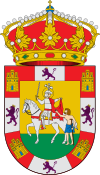Sahagún facts for kids
Quick facts for kids
Sahagún
|
|||
|---|---|---|---|
 |
|||
|
|||
| Country | Spain | ||
| Autonomous community | Castile and León | ||
| Province | León | ||
| Area | |||
| • Total | 123.64 km2 (47.74 sq mi) | ||
| Elevation | 822 m (2,697 ft) | ||
| Population | |||
| • Total | 2,517 | ||
| • Density | 20.357/km2 (52.726/sq mi) | ||
| Demonym(s) | facundino/na, sahagunense | ||
| Time zone | UTC+1 (CET) | ||
| • Summer (DST) | UTC+2 (CEST) | ||
| Postal code |
24320
|
||
| Dialing code | 987 | ||
| Official language(s) | Spanish | ||
Sahagún is a town and municipality in Spain. It is part of the Castile and León region. The town is located in the province of León. It is the main town in the Leonese part of the Tierra de Campos area.
Sahagún is famous for its special buildings. These buildings show some of the earliest examples of Mudéjar architecture. This style mixes Christian and Islamic art. The town is also on the Way of St. James. This is a famous pilgrimage route. Many people think Sahagún is the halfway point for pilgrims. It is between St. Jean Pied de Port and Santiago de Compostela.
A battle happened here in 1808. It was called the Battle of Sahagún. British light cavalry won a big victory. They defeated more French soldiers. The first settlement in Sahagún grew around a monastery. This monastery was dedicated to saints Facundus and Primitivus. The name Sahagún likely comes from "San Fagun." This means "Saint Facundus."
Villages in Sahagún
The municipality of Sahagún includes several small villages. These villages are:
- Arenillas de Valderaduey
- Celada de Cea
- Galleguillos de Campos
- Joara
- Riosequillo
- Sahagún (the main town)
- San Martín de la Cueza
- San Pedro de las Dueñas
- Sotillo de Cea
- Villalebrín
- Villalmán
The Monastery of Sahagún
The monastery in Sahagún became very important. This happened during the rule of King Alfonso III. It reached its greatest fame under Alfonso VI of Castile. On November 25, 1085, King Alfonso VI made special rules. These rules were called the Fuero de Sahagún. They gave many benefits to the monastery and the town. This helped Sahagún grow a lot.
The king really liked the Cluniac religious order. Because of this, the monastery was known as the "Spanish Cluny." Sometimes, there were fights between the townspeople and the monastery. These fights happened in the mid-12th century. They are written about in the Crónicas anónimas de Sahagún.
The monastery was a key stop on the pilgrimage route. This route leads to Santiago de Compostela. In the 14th century, the monastery even had a university. This was one of the early universities in Europe. In the 1800s, the monastery was closed down. Most of its buildings were destroyed.
Famous People from Sahagún
Some notable people have come from Sahagún:
Gallery
See also
 In Spanish: Sahagún (España) para niños
In Spanish: Sahagún (España) para niños
















